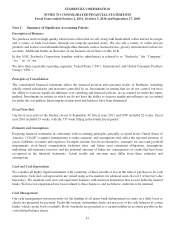Starbucks 2011 Annual Report Download - page 53
Download and view the complete annual report
Please find page 53 of the 2011 Starbucks annual report below. You can navigate through the pages in the report by either clicking on the pages listed below, or by using the keyword search tool below to find specific information within the annual report.STARBUCKS CORPORATION
NOTES TO CONSOLIDATED FINANCIAL STATEMENTS
Fiscal Years ended October 2, 2011, October 3, 2010 and September 27, 2009
Note 1: Summary of Significant Accounting Policies
Description of Business
We purchase and roast high-quality whole bean coffees that we sell, along with handcrafted coffee and tea beverages
and a variety of fresh food items, through our company-operated stores. We also sell a variety of coffee and tea
products and license our trademarks through other channels such as licensed stores, grocery and national foodservice
accounts. Additional details on the nature of our business are in Item 1 of this 10-K.
In this 10-K, Starbucks Corporation (together with its subsidiaries) is referred to as “Starbucks,” the “Company,”
“we,” “us” or “our.”
We have three reportable operating segments: United States (“US”), International, and Global Consumer Products
Group (“CPG”).
Principles of Consolidation
The consolidated financial statements reflect the financial position and operating results of Starbucks, including
wholly owned subsidiaries and investees controlled by us. Investments in entities that we do not control, but have
the ability to exercise significant influence over operating and financial policies, are accounted for under the equity
method. Investments in entities in which we do not have the ability to exercise significant influence are accounted
for under the cost method. Intercompany transactions and balances have been eliminated.
Fiscal Year End
Our fiscal year ends on the Sunday closest to September 30. Fiscal years 2011 and 2009 included 52 weeks. Fiscal
year 2010 included 53 weeks, with the 53rd week falling in the fourth fiscal quarter.
Estimates and Assumptions
Preparing financial statements in conformity with accounting principles generally accepted in the United States of
America (“GAAP”) requires management to make estimates and assumptions that affect the reported amounts of
assets, liabilities, revenues and expenses. Examples include, but are not limited to, estimates for asset and goodwill
impairments, stock-based compensation forfeiture rates, and future asset retirement obligations; assumptions
underlying self-insurance reserves; and the potential outcome of future tax consequences of events that have been
recognized in the financial statements. Actual results and outcomes may differ from these estimates and
assumptions.
Cash and Cash Equivalents
We consider all highly liquid instruments with a maturity of three months or less at the time of purchase to be cash
equivalents. Cash and cash equivalents are valued using active markets for identical assets (Level 1 of the fair value
hierarchy). We maintain cash and cash equivalent balances with financial institutions that exceed federally insured
limits. We have not experienced any losses related to these balances, and we believe credit risk to be minimal.
Cash Management
Our cash management system provides for the funding of all major bank disbursement accounts on a daily basis as
checks are presented for payment. Under this system, outstanding checks are in excess of the cash balances at certain
banks, which creates book overdrafts. Book overdrafts are presented as a current liability in accounts payable on the
consolidated balance sheets.
47
























